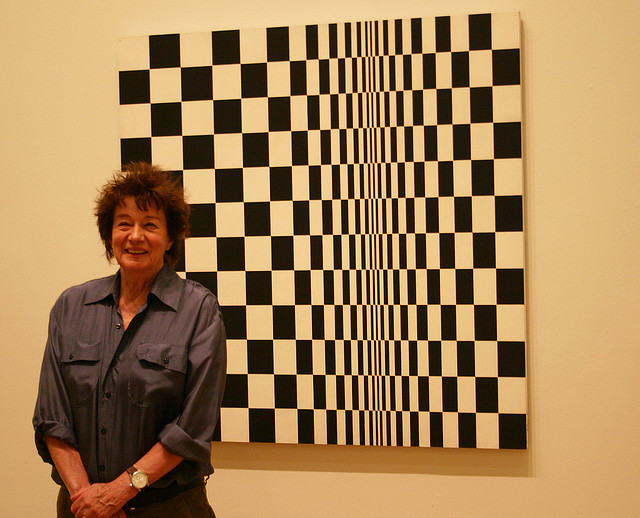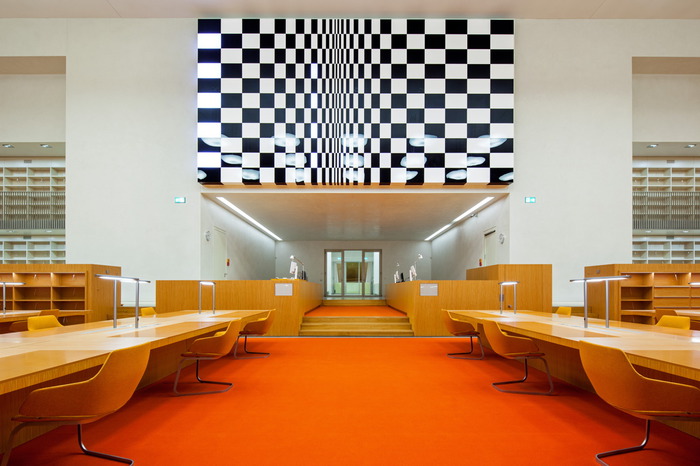I hadn't heard of this before. The Art Newspaper and several German sources report that a Bridget Riley and Tobias Rehberger have come to an agreement in a plagiarism lawsuit Riley brought last year in a Berlin court.
Riley had demanded that Rehberger's work, Uhrenobjekt/Watch Object installed in the new National Library Unter den Linden, be removed because it copied her foundational 1961 painting, Movement in Squares. Last Spring, the court denied Riley's removal request, but ordered the Uhrenobjekt covered until the plagiarism issue was resolved.
It was, and now the work will go back on view, with a new title, Uhrenobjekt nach Movement in Squares von Bridget Riley (Watch Object after Movement in Squares by Bridget Riley). This seems pretty reasonable. I hope Riley's cool with it. I know she's had to deal with knockoff/transformations of her paintings by the fashion industry since the beginning. The story of MoMA's Bill Weitz and Larry Aldrich deciding on their own it'd be awesome to make Riley-inspired dresses timed for the 1965 show, "The Responsive Eye" is a must-read. Story of her life.
So I was kind of fascinated as to what Rehberger's original idea for his piece was. Was it actually "from" Riley's work, or did it just happen to look like it? Wouldn't it be weird to namecheck her if her work hadn't been part of the process somehow? News reports don't give any details about arguments made by either side. Most German reports from the initial phase of the suit are sympathetic to the hometown boy, like this Tage Spiegel article, and include a list of the specific differences between Riley's and Rehberger's Op Art grids, and lay out a random list of examples of painters borrowing and copying motifs through history. I'd say that the German interpretation of the case is that Rehberger "won."

Bridget Riley in front of Movement in Squares, 1961, image: nml
Again, though, what was his point in making this object? It can't be that he didn't know of Riley's painting; he's been soaking in Op for a long time, and Movement in Squares is Riley's foundational Op Art work, the one she credits with setting her on her geometric, optically invigorating, abstract path. It went into the Arts Council's collection almost immediately, and has been in tons of Riley shows and catalogues. [Amusingly enough, it takes a bit of effort to find actual pictures of the painting itself, something that doesn't look like a pattern. This may be a feature/weakness of Op Art, it's ready transformation into pattern and image. But never mind, here's a 2009 photo from the National Museums, Liverpool of the artist standing in front of her painting. It's 4x4 feet square, tempera on hardboard, a very human scale and presence.]

Both images of the Rare Book Room of the National Library by JF Mueller, via detail.de
So turning back the clock, I found this preview of the Staatsbibliothek project from the German architecture site Detail. The optical pattern is flipped, obviously, but more than that, the physical aspect of Rehberger's Uhrenobjekt is quite different: it's rectangular, fit to the doorway. And it's thick. Architectural. And it's way up the wall, and super-shiny. The text describes it as "an interpretation of" Movement in Squares with "partly illuminated areas that show time in an unconventional way." So yes, it's an acknowledged interpretation whose main feature is apparently to be a reflective surface for the play of light over the day. Which is not irrelevant, because determining plagiarism vs interpretation/transformation/whatever the German equivalent of fair use is, brings the whole host of differences between the works and their context into play. And then there's the fundamental distinction between Objekt and Bild, object and picture, and all that entails.
Agreement reached in plagiarism row between artists [TAN via @artnet]
Huh? What's that? Die große Karo-Frage [berliner-zeitung.de]
Previously, super-related: The Trendmaking Eye













